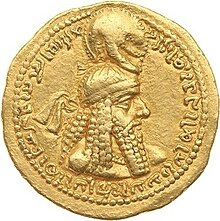
Back Ardasjir I Afrikaans أردشير الأول Arabic اردشير الاول ARZ I Ərdəşir Azerbaijani Ардашир I Bulgarian প্রথম আর্দাশির Bengali/Bangla Ardaixir I Catalan Ardešir I CEB ئەردەشێر بابەکان CKB Ardašír I. Czech
| Ardashir I 𐭠𐭥𐭲𐭧𐭱𐭲𐭥 | |
|---|---|
| King of Kings of Persia | |
 Gold dinar of Ardashir I, 230 AD | |
| King of Persis | |
| Reign | 211/2–224 |
| Predecessor | Shapur |
| Successor | Office abolished |
| Shahanshah of the Sasanian Empire | |
| Reign | 224–242 |
| Coronation | 226 Ctesiphon |
| Predecessor | Artabanus IV (Parthian Empire) |
| Successor | Shapur I |
| Co-ruler | Shapur I (240–242) |
| Born | Unknown Tiruda, Khir, Pars |
| Died | February 242 |
| Spouse | Denag Murrod |
| Issue | Shapur I |
| House | House of Sasan |
| Father | Pabag or Sasan |
| Mother | Rodag |
| Religion | Zoroastrianism |
Ardashir I (Middle Persian: 𐭠𐭥𐭲𐭧𐭱𐭲𐭥, romanized: Ardašīr), also known as Ardashir the Unifier[1] (180–242 AD), was the founder of the Persian Sasanian Empire. He was also Ardashir V of the Kings of Persis, until he founded the new empire. After defeating the last Parthian shahanshah Artabanus IV on the Hormozdgan plain in 224, he overthrew the Arsacid dynasty and established the Sasanian dynasty. Afterwards, Ardashir called himself "shahanshah" and began conquering the land that he called Iran.[2][3]
There are various historical reports about Ardashir's lineage and ancestry. According to Al-Tabari's History of the Prophets and Kings, Ardashir was son of Papak, son of Sasan. Another narrative that exists in Kar-Namag i Ardashir i Pabagan and Ferdowsi's Shahnameh also states it says that Ardashir was born from the marriage of Sasan, a descendant of Darius III, with the daughter of Papak, a local governor in Pars.
According to Al-Tabari's report, Ardashir was born in the outskirts of Istakhr, Pars. Al-Tabari adds that Ardashir was sent to the lord of Fort Darabgard when he was seven years old. After the lord's death, Ardashir succeeded him and became the commander of Fort Darabgard. Al-Tabari continues that afterward, Papak overthrew the local Persian shah named Gochihr and appointed his son, Shapur, instead of him. According to Al-Tabari's report, Shapur and his father, Papak, suddenly died and Ardashir became the ruler of Pars. Tension rose between Ardashir and the Parthian empire and eventually on April 28, 224, Ardashir faced the army of Artabanus IV in the Hormozdgan plain and Artabanus, the Parthian shahanshah, was killed during the battle.
According to the royal reports, it was Papak who overthrew Gochihr, the local Persian shah, and appointed his son, Shapur, instead of him; Ardashir refused to accept Shapur's appointment and removed his brother and whosoever stood against him and then minted coins with his face drawn on and his father, Papak's behind. It is probable that the determining role that is stated about Ardashir in leading the rebellion against the central government is the product of the later historical studies. Papak had probably united most of Pars under his rule by then.
Ardashir had an outstanding role in developing the royal ideology. He tried to show himself as a worshiper of Mazda related to god and possessing khvarenah. The claim of the legitimacy of his reign as a rightful newcomer from the line of the mythical Iranian shahs and the propagations attributed to Ardashir against the legitimacy and role of the Parthians in the Iranian history sequence show the valuable place that the Achaemenid legacy had in the minds of the first Sasanian shahanshahs; though the current belief is that the Sasanians did not know much about the Achaemenids and their status. On the other hand, some historians believe that the first Sasanian shahanshahs were familiar with the Achaemenids and their succeeding shahanshahs deliberately turned to the Kayanians. They knowingly ignored the Achaemenids in order to attribute their past to the Kayanians; and that was where they applied holy historiography.
In order to remark his victories, Ardashir carved petroglyphs in Firuzabad (the city of Gor or Ardashir-Khwarrah), Naqsh-e Rajab and Naqsh-e Rustam. In his petroglyph in Naqsh-e Rustam, Ardashir and Ahura Mazda are opposite to each other on horsebacks and the corpses of Artabanus and Ahriman are visualized under the hooves of the horses of Ardashir and Ahura Mazda. It can be deduced from the picture that Ardashir assumed or wished for others to assume that his rule over the land that was called "Iran" in the inscriptions was designated by the lord. The word "Iran" was previously used in Avesta and as "the name of the mythical land of the Aryans". In Ardashir's period, the title "Iran" was chosen for the region under the Sasanian rule. The idea of "Iran" was accepted for both the Zoroastrian and non-Zoroastrian societies in the whole kingdom and the Iranians' collective memory continued and lived on in the various stages and different layers of the Iranian society until the modern period today. What is clear is that the concept of "Iran" previously had a religious and ethnic application and then ended up creating its political face and the concept of a geographical collection of lands.